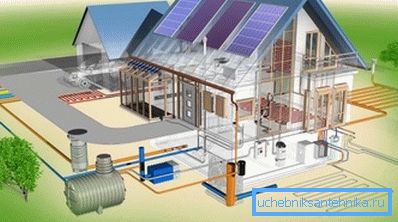Sewage station - device, principle of operation and types
Why do many city dwellers try to go beyond the megalopolis at least a few days a month? The answer is obvious - even such a short period of stay in clean fresh air gives them a charge for the rest of the time. At the same time, a country house or a country house must be equipped with some benefits of civilization so that the rest is truly full.

General information
In this case we are talking about the discharge of polluted wastewater. This issue should always be resolved at the design stage of any house. You will be lucky if the central sewage collector passes nearby or if you have the opportunity to install a septic tank.
Otherwise, you will need a sewage pumping station (SPS), which will provide an opportunity to pump dirty water to treatment plants located nearby, or into the main drainage system.
Below in the article we will tell:
- about her device;
- about the principle of operation of the equipment;
- about varieties of CNS.
Device
The station is inherently a sealed drain pit, which is equipped with one or more pumps. With their help, and is the transportation of wastewater in the right direction. Let's select the main elements of the equipment:
| Storage tank |
|
| Fecal pump | Make installation of two units:
Their task is to raise wastewater to the desired level, and not to create pressure in the system. After that, they go on by gravity. |
| Piping system |
|
| Float switches | The instruction recommends installing three or four floats in order to organize complete control over the system in the event of any failure. They are designed to automatically turn the pump on and off in the system. Their work is organized as follows:
If the main pump does not turn on, the 3rd and 4th floats start the standby unit. |

Also such household KNS equipped with:
- a staircase to facilitate their maintenance;
- lid with inspection and inspection holes;
- switchboard designed to control the flow of electrical energy to the station.
Additional recommendations:
- Pay special attention to pumps for CND. They are usually of the submersible type and mounted on chains or vertical guides. This makes it possible to quickly and easily replace units in the event of a breakdown.
Tip: when replacing one pump, the station can not stop.
- Ventilation is also an important component of the system.
It is mounted on the lid, and it consists of two branch pipes emerging from it:
- one for fresh air inflow into the station;
- the second is to remove contaminated.
In expensive KNS, the latter is equipped with a filtration system.
Tip: put your hands on the lid of the additional pipe, dropping it almost to the bottom of the storage tank. This way you can safely remove wastewater from the tank.

Types of KNS
Today, manufacturers offer two main types of such equipment - for domestic and industrial needs. The second includes huge stations that are designed to collect wastewater from a large number of residential buildings. In this article, we do not consider them, and more time is devoted to mini-sewer pumping station.

They can also be of two kinds, for work:
- with one sanitary device (for example, a toilet bowl);
- with several bathrooms.
Tip: installing a mini-KNS is advisable if the central sewer is located far enough from the house, and when the sanitary facilities were located in the basement floors.

Where to install
If the plan of the house provides for the placement of sanitary facilities below the ground floor level and it is impossible to carry out the flow of sewage there, you need to install a mini-KNS directly inside the bathroom. Usually - between the conclusion of the toilet and sewage. This type of equipment is also a shredder for household waste, and for its connection no large sewer pipes are needed. The devices have an outlet opening up to O40 mm or, most often O32 mm.

When the distance from the house to the sewer is quite a long distance, you will need a typical project of a sewage pumping station to install it outside the house. It will be a full-fledged CND, but only in miniature.
Particular attention when choosing it should be paid to the capacity of the storage tank, which should correspond to the water consumption for 24 hours divided by 4. So you can save energy to operate the equipment more economically.
Conclusion
From the article you learned that a sewage pumping station is a device designed to transfer wastewater from a house in a certain direction: to sewage treatment plants or to a central sewer (see also Forced sewage: main types and features of their use).
Of course, you can install and adjust everything yourself, but we recommend to contact the experts in this case.
The video in this article will help you find additional information on this topic.